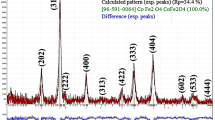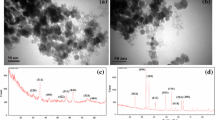Abstract
In the present study, nanoscale iron oxide was synthesized using a hydrothermal method; XRD analysis revealed that all the produced crystals are iron oxide. FESEM microscopic imaging showed that particles are on the scale of nano and their morphology is cloud fractal. To study the laboratory properties of thermal conductivity, viscosity, and electrical conductivity of the nanoparticles, they were dispersed in ethylene glycol-based fluid and the nanofluid was in a two-step synthesis during this process. The experiments were carried out with a weight fraction between 0 and 2 % at temperatures between 25 and 45 °C. According to the results of the experiments, increasing the density of nanoparticles in the fluid increases thermal conductivity, as it was predicted in all theoretical models. On the other hand, nano viscosity increases as the weight fraction increases while it decreases as temperature goes up. Electrical conductivity also increases with raising the temperature and weight fraction. Theoretical models were studied to predict Thermal conductivity, viscosity, and electrical conductivity of the nanofluid.















Similar content being viewed by others
References
Choi SUS (1995) Enhancing thermal conductivity of fluids with nanoparticles. In: Siginer DA, Wang HP (eds) Developments and applications of non-Newtonian flows, FED, vol 231/MD, vol 66. ASME, New York, pp 99–103
Zawrah MF, Khattab RM, Girgis LG, El Daidamony H, Abdel Aziz Rehab E (2007) Stability and electrical conductivity of water-base, Al2O3 nanofluids for different applications. Housing and Building National Research Center, Giza. doi:10.1016/j.hbrcj.2014.12.001
Choi SUS, Zhang ZG, Lockwood FE, Grulke EA (2001) Anomalous thermal conductivity enhancement in nanotube suspensions. Appl Phys Lett 79:2252–2254
Lee S, Choi SUS, Li S, Eastman JA (1999) Measuring thermal conductivity of fluids containing oxide nanoparticles. J Heat Transf 121:280–289
Masuda H, Ebata A, Teramae K, Hishinuma N (1993) Alteration of thermal conductivity and viscosity of liquid by dispersing ultra-fine particles (dispersion of Al2O3, SiO2 and TiO2 ultra fine particles). Netsu Bussei 4:227–233
Pak BC, Cho YI (1998) Hydrodynamic and heat transfer study of dispersed fluids with submicron metallic oxide particles. Exp Heat Transf 11:151–170
Eastman JA, Choi SUS, Li S, Yu W, Thompson LJ (2001) Anomalously increased effective thermal conductivities of ethylene glycol based nanofluids containing copper nanoparticles. Appl Phys Lett 78:718–720
Das SK, Putra N, Thiesen P, Roetzel W (2003) Temperature dependence of thermal conductivity enhancement for nanofluids. J Heat Transf 125:567–574
Xuan Y, Li Q, Zhang X, Fujii M (2006) Stochastic thermal transport of nanoparticle suspensions. J Appl Phys 100:043507–043507-6
Murshed SMS, Leong KC, Yang C (2005) Enhanced thermal conductivity of TiO2–water based nanofluids. Int J Therm Sci 44:367–373
Timofeeva EV, Gavrilov AN, McCloskey JM, Tolmachev YV (2007) Thermal conductivity and particle agglomeration in alumina nanofluids: experiment and theory. Phys Rev 76:061203-043507-15
Prasher R, Song D, Wang J, Phelan P (2006) Measurements of nanofluid viscosity and its implications for thermal applications. Appl Phys Lett 89:133108–133108-3
Xiao C, Gao L, Lu M, Chen H, Guo L, Tao L (2010) Synergistic effect of copolymer and poly(vinylpyrrolidone) mixtures on rheology of aqueous SiC suspensions. Colloids Surf A 355:104–108
Chen H, Witharana S, Jina Y, Kim C, Ding Y (2009) Predicting thermal conductivity of liquid suspensions of nanoparticles (nanofluids) based on rheology. Particuology 7:151–157
Kole M, Dey TK (2010) Viscosity of alumina nanoparticles dispersed in car engine coolant. Exp Therm Fluid Sci 34:677–683
Abareshi M, Goharshadi E, Zebarjad SM, Fadafan HK, Youssefi A (2010) Fabrication, characterization and measurement of thermal conductivity of Fe3O4 nanofluids. J Magn Magn Mater 322:3895–3901
Saidur R, Leong KY, Mohammad HA (2011) A review on applications and challenges of nanofluids. Renew Sustain Energy Rev 15:1646–1668
Prasher R, Bhattacharya P, Phelan PE (2005) Thermal conductivity of nanoscale colloidal solutions (nanofluids). Phys Rev Lett 94:025901–025901-3
Maxwell JC (1881) A treatise on electricity and magnetism, 2nd edn. Clarendon Press, Oxford
Hamilton RL, Crosser OK (1962) Thermal conductivity of heterogeneous two component systems. Ind Eng Chem Fundam 1:187–191
Xue QZ (2003) Model for effective thermal conductivity of nanofluids. Phys Lett A 307:313–317
Mehta S, Chauhan KP, Kanagaraj S (2011) Modeling of thermal conductivity of nanofluids by modifying Maxwell’s equation using cell model approach”. J Nanopart Res 13:2791–2798
Mahbubul IM, Saidur R, Amalina MA (2012) “Latest developments on the viscosity of nanofluids. Int J Heat Mass Transf 55:874–885
Ganguly S, Sikdar S Sikdar, Basu S (2009) Experimental investigation of the effective electrical conductivity of aluminum oxide nanofluids. Powder Technol 196:326–330
Minea AA, Luciu RS (2012) Investigations on electrical conductivity of stabilized water based Al2O3 nanofluids. Microfluid Nanofluid 13:977–985
White SB, Shih AJ, Pipe KP (2011) Investigation of the electrical conductivity of propylene glycol-based ZnO nanofluids. Nanoscale Res Lett 6:346–350
Shen LP, Wang H, Dong M, Ma ZC, Wang HB (2012) Solvothermal synthesis and electrical conductivity model for the zinc oxide-insulated oil nanofluid. Phys Lett A 376:1053–1057
Dong M, Shen LP, Wang H, Wang HB, Miao J (2013) Investigation on the electrical conductivity of transformer oil-based AlN nanofluid. J Nanomater. doi:10.1155/2013/842963
Maxwell JC (1881) An elementary treatise on electricity. Clarendon Press, Oxford
Einstein A (1956) Investigations on the theory of the Brownian movement. Dover, New York
Maxwell JC (1904) A treatise on electricity and magnetism, 2nd edn. Oxford University Press, Cambridge
Cruz RCD, Reinshagen J, Oberacker R, Segadães AM, Hoffmann MJ (2005) Electrical conductivity and stability of concentrated aqueous alumina suspensions. J Colloid Interface Sci 286:579–588
Sundar LS, Singh MK, Sousa ACM (2013) Investigation of thermal conductivity and viscosity of Fe3O4 nanofluid for heat transfer applications. Int Commun Heat Mass Transf 44:7–14
Jang SP, Choi SUS (2004) Role of Brownian motion in the enhanced thermal conductivity of nanofluids. Appl Phys Lett 84:4316–4318
Baghelia S, Khandan Fadafana H, Lotfi Orimia R, Ghaemib M (2015) Synthesis and experimental investigation of the electrical conductivity of water based magnetite nanofluids. Powder Technol 274:426–430
Dutka M, Ditaranto M, Løvås T (2015) Application of a central composite design for the study of NOx emission performance of a low NOx burner. Energies 8:3606–3627
Shahabadi SMS, Reyhani A (2014) Optimization of operating conditions in ultrafiltration process for produced water treatment via the full factorial design methodology. Sep Purif Technol 132:50–61
Shahabadi SMS, Mousavi SA, Bastani D (2016) High flux electrospun nanofibrous membrane: preparation by statistical approach, characterization, and microfiltration assessment. J Taiwan Inst Chem Eng 59:474–483
Author information
Authors and Affiliations
Corresponding author
Rights and permissions
About this article
Cite this article
Jamilpanah, P., Pahlavanzadeh, H. & Kheradmand, A. Thermal conductivity, viscosity, and electrical conductivity of iron oxide with a cloud fractal structure. Heat Mass Transfer 53, 1343–1354 (2017). https://doi.org/10.1007/s00231-016-1891-5
Received:
Accepted:
Published:
Issue Date:
DOI: https://doi.org/10.1007/s00231-016-1891-5




